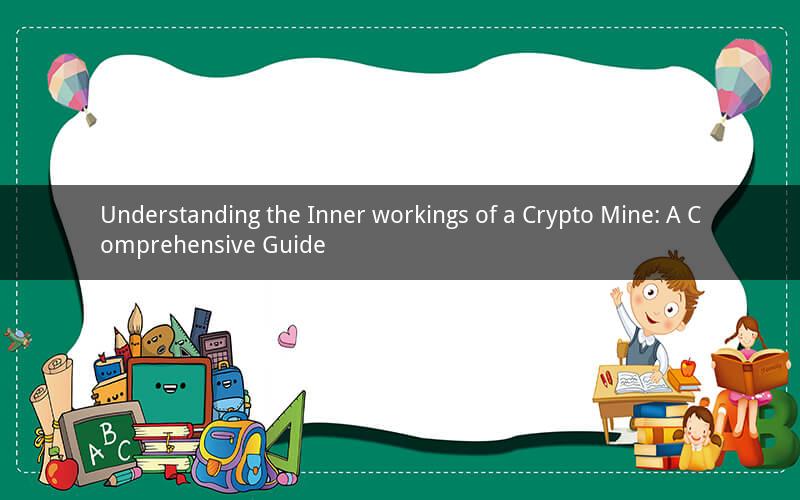
In the digital age, cryptocurrencies have become a significant part of our financial landscape. Mining, the process of validating transactions and adding them to a blockchain, is crucial for the operation of these digital currencies. How does a crypto mine work? This article delves into the intricacies of crypto mining, exploring the hardware, software, and processes involved.
Hardware: The Backbone of Crypto Mining
Crypto mining requires specialized hardware, known as ASICs (Application-Specific Integrated Circuits), to solve complex mathematical problems. These problems are essential for validating transactions and securing the blockchain. The following components are crucial for a crypto mine:
1. ASIC Miners: These are the workhorses of crypto mining, designed to perform the computational tasks required for mining. They are more efficient than traditional CPUs and GPUs due to their optimized design for mining algorithms.
2. Motherboards: Motherboards connect the various components of the crypto mine, ensuring they communicate effectively. A robust motherboard is essential for stability and performance.
3. Power Supply Units (PSUs): PSUs provide the necessary power for all the components in the crypto mine. High-quality PSUs with sufficient power output are crucial to avoid overheating and other issues.
4. Cooling Systems: Crypto mining generates a significant amount of heat. Efficient cooling systems, such as air or liquid coolers, are essential to maintain optimal temperatures and prevent hardware damage.
Software: The Brain Behind Crypto Mining
Crypto mining software is responsible for managing the mining process, including communicating with the mining hardware and solving the complex mathematical problems. Here are some key software components:
1. Mining Pools: Mining pools are groups of miners who combine their resources to increase their chances of solving a block and earning rewards. Joining a mining pool can improve your chances of earning a profit, especially for smaller miners.
2. Mining Software: Mining software, such as CGMiner or BFGMiner, communicates with the ASIC miners and manages the mining process. These programs can be configured to mine specific cryptocurrencies and optimize performance.
3. Wallets: Cryptocurrency wallets store your digital assets and allow you to access them. A wallet is necessary to receive your mining rewards and manage your crypto assets.
The Mining Process: From Start to Finish
The crypto mining process involves several steps, from setting up the hardware to receiving your rewards. Here's a high-level overview:
1. Choose a Cryptocurrency: Decide which cryptocurrency you want to mine. This will determine the hardware and software requirements for your crypto mine.
2. Set Up the Hardware: Assemble your ASIC miners, motherboards, PSUs, and cooling systems. Ensure that all components are compatible and connected correctly.
3. Install Mining Software: Install the appropriate mining software on your computer or server. Configure the software to mine your chosen cryptocurrency and connect to a mining pool, if applicable.
4. Start Mining: Once everything is set up, start the mining process. Your ASIC miners will begin solving the complex mathematical problems required for mining.
5. Monitor and Maintain: Keep an eye on your crypto mine's performance, ensuring that everything is running smoothly. Regularly update your mining software and hardware to maintain optimal performance.
6. Receive Rewards: When your mining hardware solves a block, you will receive a portion of the block reward, depending on your mining pool's share. These rewards will be sent to your cryptocurrency wallet.
Challenges and Considerations
While crypto mining can be profitable, it's essential to be aware of the challenges and considerations involved:
1. Energy Consumption: Crypto mining requires a significant amount of electricity. Ensure that your energy costs are manageable and that you are using renewable energy sources, if possible.
2. Market Volatility: Cryptocurrency prices can be highly volatile, impacting your mining profitability. Stay informed about market trends and adjust your mining strategy accordingly.
3. Hardware Maintenance: Regularly maintain your mining hardware to ensure optimal performance and longevity. This includes cleaning fans, replacing filters, and checking for any signs of wear and tear.
4. Security: Keep your crypto mine secure from physical theft and cyber attacks. Use secure passwords, firewalls, and other security measures to protect your assets.
5. Legal and Regulatory Issues: Be aware of the legal and regulatory environment surrounding crypto mining in your region. Some countries may have restrictions or outright bans on mining activities.
Frequently Asked Questions
1. Q: Can anyone start a crypto mine?
A: Yes, anyone with the necessary hardware, software, and knowledge can start a crypto mine. However, it's essential to understand the challenges and requirements involved.
2. Q: What is the most profitable cryptocurrency to mine?
A: The most profitable cryptocurrency to mine can vary depending on factors such as electricity costs, hardware efficiency, and market conditions. Research and stay informed about the best options for your specific circumstances.
3. Q: How long does it take to mine a cryptocurrency?
A: The time it takes to mine a cryptocurrency can vary widely, depending on the difficulty of the mining algorithm and the computing power of your hardware. Some cryptocurrencies can be mined in a matter of minutes, while others may take days or weeks.
4. Q: Can I mine cryptocurrencies using my regular computer?
A: While it's possible to mine cryptocurrencies using a regular computer, it's not recommended. CPUs and GPUs are not as efficient as ASICs for mining, and you may not earn a significant profit.
5. Q: Is crypto mining worth it?
A: Whether crypto mining is worth it depends on various factors, including your hardware, electricity costs, and market conditions. Conduct thorough research and consider your long-term goals before deciding to start mining.